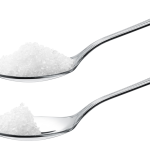Too Much Sugar is a guest post written by Diane Atwood, shared by Advantage Home Care. My mother Beverly loves her sweets, especially chocolate. When I was growing up, she wouldn’t buy just one candy bar, she’d buy the whole box and she wasn’t one for sharing. You see, it was bad for our health. But for her, it was salvation at the end of a weary day dealing with eight darling children.
 Mom is 88-years-old now and lives in a memory care facility. Her sweet tooth is going just as strong as she still is. The problem is she will sometimes eat one candy bar after another, to the point that she’s not hungry for a regular meal. One day a caregiver mentioned that my mother seemed a bit lightheaded that morning and she noticed a pile of candy bar wrappers in the wastebasket beside her chair. It was nearly empty the night before. Too much sugar!
Mom is 88-years-old now and lives in a memory care facility. Her sweet tooth is going just as strong as she still is. The problem is she will sometimes eat one candy bar after another, to the point that she’s not hungry for a regular meal. One day a caregiver mentioned that my mother seemed a bit lightheaded that morning and she noticed a pile of candy bar wrappers in the wastebasket beside her chair. It was nearly empty the night before. Too much sugar!
What too much sugar can do
When you eat a lot of sugar it can make your body demand more insulin, a hormone that helps convert food into energy. When we eat, the body breaks down sugar and starches from our food into glucose — the body’s fuel — and insulin carries it to our cells. When that process slows down or stops working, glucose (sugar) builds up in the blood.
Symptoms of too much sugar in the blood
- Fatigue
- Hunger
- Brain fog
- High blood pressure
A higher than normal blood sugar level doesn’t mean you have diabetes, but you may at risk of eventually developing the disease if you have too much sugar. We’re talking about the risk of developing type 2 diabetes, which is what 90 percent of all people with diabetes have. Most cases of type 2 diabetes are related to weight and lifestyle. It develops because your body either doesn’t produce enough insulin anymore or doesn’t use the insulin that is produced.
The other kind, type 1, happens when the body can’t produce insulin. It has nothing to do with weight or lifestyle — it’s caused by a malfunctioning pancreas.
 Type 2 diabetes usually develops slowly — a decade or longer. It generally progresses from normal blood glucose to impaired fasting glucose (IFG) or impaired glucose tolerance (IGT) to diabetes. When the glucose level is slightly higher than normal, some people refer to it as prediabetes.
Type 2 diabetes usually develops slowly — a decade or longer. It generally progresses from normal blood glucose to impaired fasting glucose (IFG) or impaired glucose tolerance (IGT) to diabetes. When the glucose level is slightly higher than normal, some people refer to it as prediabetes.
Sweets like my mother loves can load up the blood with too much sugar, but so can other foods. Carbohydrates, for example, turn into sugar when they’re digested. But a sugary diet isn’t the only diabetes risk factor.
TYPE 2 Diabetes Risk Factors
Diabetes is probably caused by a combination of genetic and environmental factors — some that can be controlled and some that can’t. There are several risk factors that increase a person’s chances of developing the disease.
- Obesity: If you have a body mass index (BMI) greater than 29, your odds increase to one in four
- Age: The risk increases with age, especially after 45
- Inactivity: The less active you are the greater your risk
- Family history: Risk increases if a parent or sibling had type 2 diabetes
- Diet: High in sugar, cholesterol and processed food
- Diagnosis of heart disease or high cholesterol
- Race: More prevalent in people of certain races, including African-Americans, Hispanics, American Indians, Asian-Americans and Pacific Islanders
- Gestational diabetes: If you had gestational diabetes during pregnancy or had a baby that weighed more than nine pounds, your risk is increased
- Polycystic ovary syndrome increases the risk
- Sleep: Research suggests that regularly sleeping fewer than six hours or more than nine hours a night might increase your risk
Decreasing your risk of diabetes
If you or someone you’re caring for has any of the above risk factors, it would be a good idea to get a blood sugar test. Even when it’s normal, any risk factors that can be changed could make a difference. For instance, research shows that people can prevent or delay type 2 diabetes if they lose 5 to 7 percent of their body weight and get at least one-half hour of moderate physical activity five days a week.
Amazingly, my mother doesn’t have (too much sugar)elevated blood sugar. It could be genetics, but I think it also has to do with diet and exercise. Candy aside, she gets three healthy meals a day and while she’s not keen on organized exercise programs, she does a lot of walking, especially to and from visits with other residents and participating in various activities.
When an elderly person is still living at home, eating a healthy diet and getting some exercise may be a bit more challenging. That’s where the caregivers from Advantage Home Care can be a huge help.
For instance, here’s how caregivers can help with mealtime:
- Meal planning
- Meal preparation
- Prepare future meals
- Prepare grocery list
- Clip coupons for shopping
- Monitor food freshness & expirations
- Monitor diet & eating habits
If you’d like to know about all the services Advantage Home Care can provide, visit the website or give them a call: 207-699-2570 or toll free 1-888-846-1410
As for my mother, she’s doing fine and still gets her candy bars, but we’re trying to minimize the stash she keeps in her bureau drawer. Family and friends — please don’t bring her the biggest bag of Kit Kat bars you could find when you pay her a visit! Too much sugar!
Advantage Home Care’s Aging in Place blog is written by Diane Atwood, who also writes the blog Catching Health with Diane Atwood (and often writes about her mother’s sweet tooth and the danger of too much sugar).